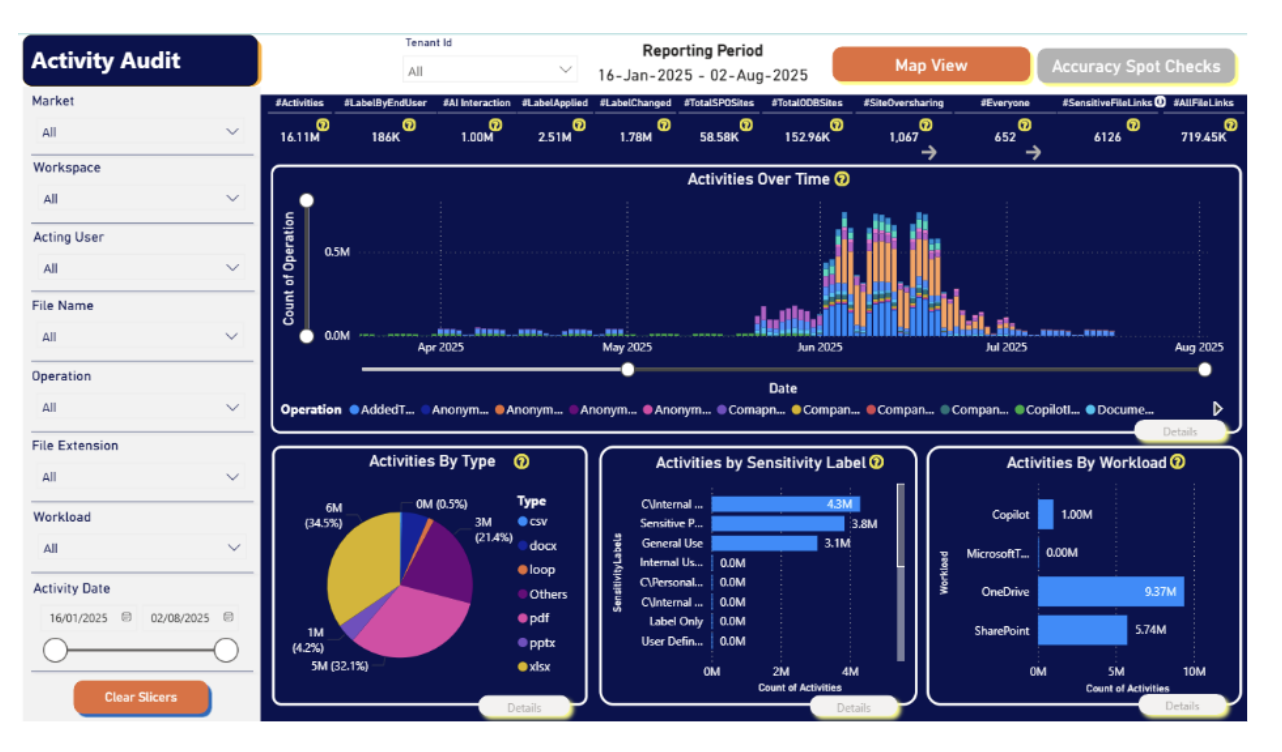![]()
IT security audits are meant to validate that an organization’s information assets are secure and compliant. Regulators, boards, and customers expect assurance that risks are managed against standards and regulations such as ISO/IEC 27001, NIST SP 800-171/53, PCI DSS, HIPAA, and GDPR.
For CISOs, audits should showcase security maturity. Instead, they often become a repetitive, resource-intensive pain point with high personal and organizational stakes.
Why Audits Are Painful for CISOs
High Stakes & Accountability – A failed audit damages credibility with boards, regulators, and customers.
Resource Drain – Audit prep consumes weeks of team effort, pulling staff away from actual threat management.
Fragmented Evidence – Logs and records spread across M365, Azure, AWS, GCP, HR systems, ERP, ticketing tools, and SaaS platforms.
Repeated Findings – The same control gaps (privileged accounts, patching, ROT data) surface every year.
Cross-Functional Headaches – Evidence collection requires cooperation across IT, HR, Legal, and business functions.
Evolving Scope – Auditors increasingly ask about cloud misconfigurations, SaaS data sprawl, vendor risk, and—more recently—AI governance in early-adopting industries.
Board & Regulator Pressure – Results must be translated into business-risk language for non-technical stakeholders.
Key NIST Audit Requirements (Examples)
From NIST SP 800-171 & SP 800-53:
- Audit Logging (AU-2 / AU-6 / 3.3.1): Generate, protect, and review audit logs.
- Access Control (AC-2 / AC-6 / 3.1.5): Manage accounts, enforce least privilege, restrict privileged functions.
- Identification & Authentication (IA-2 / 3.5.2): Use MFA, unique IDs, secure session management.
- System & Communication Protection (SC-12 / SC-13 in 800-53 / 3.13.11 in 800-171): Manage encryption keys and apply FIPS-validated cryptography for data in transit and at rest.
- Vulnerability & Configuration Management (CM-2 / CM-6 / RA-5 / 3.11.2): Maintain secure baselines, define configuration settings, scan for vulnerabilities, remediate issues.
- Planning & Accountability (PL-2 in 800-53): Define roles, responsibilities, and security plans for all systems. (Note: NIST SP 800-171 has no PL-2 control—3.1.2 relates to access control.)

Key ISO/IEC 27001 Audit Requirements (Examples)
From Annex A Controls (2013 edition for numbering consistency):
- A.5.1 – Policies: Document, approve, and review information security policies.
- A.9 – Access Control: User provisioning, access reviews, least privilege, segregation of duties.
- A.10 – Cryptography: Establish and enforce use of cryptographic controls.
- A.12 – Operations Security: Logging, monitoring, vulnerability management, anti-malware.
- A.13 – Communications Security: Secure networks, encryption of data in transit.
- A.15 – Supplier Relationships: Contracts and monitoring of third-party providers.
- A.16 – Incident Management: Formal processes for reporting, response, and evidence retention.
- A.18 – Compliance: Ensure adherence to legal, regulatory, and contractual requirements.
Note: The 2022 edition reorganized controls into 4 categories and 93 controls. Many organizations still reference 2013 numbering during audits.
How Microsoft Security Solutions Support Audit Readiness (Examples)
- Microsoft Purview → Information protection, sensitivity labels, DLP, records management. (Supports ISO A.9, A.12; NIST AC-2, AU-2).
- Microsoft Entra ID → Access reviews, conditional access, identity lifecycle. (Supports ISO A.9; NIST AC-2/6, IA-2, AC-17).
- Microsoft Defender & Sentinel → Logging, monitoring, incident detection and response. (Supports ISO A.12, A.16; NIST AU-6, IR-4).
- Microsoft Intune → Device compliance and configuration enforcement. (Supports ISO A.12; NIST CM-2, CM-6).
⚠️ Important: Microsoft tools provide technical capabilities that support compliance. Full audit alignment still requires policies, processes, and governance.
How Infotechtion-ARM (i-ARM) Data Compliance Analytics Improves Audits
✅ Unified Governance Across Systems
- Extends beyond Microsoft 365 to integrate with HR, ERP, ticketing, cloud, and security systems.
- Provides single pane reporting across the hybrid IT landscape.
✅ Automated Audit Evidence
- Collects and standardizes logs, classification reports, access reviews, and retention status.
- Generates audit-ready packages mapped to NIST and ISO requirements.
✅ Risk Reduction Before Audit
- Detects oversharing, excessive privileges, and ROT/dark data.
- Automates lifecycle management and corrective actions to eliminate repeat findings.
✅ Accountability Dashboards
- Maps owners to controls and information assets.
- Enables CISOs to show regulators and auditors who owns what.
✅ Efficiency & Cost Savings
- Cuts audit preparation time from weeks to hours.
- Reduces audit fatigue across compliance frameworks (NIST, ISO, SOC, GDPR, HIPAA).
In Summary
CISOs face audit pain because proving compliance across NIST, ISO/IEC 27001, and regulatory frameworks like GDPR and HIPAA requires fragmented evidence, manual effort, and repeated cycles of findings.
Microsoft’s native security solutions provide the technical controls, while Infotechtion i-ARM delivers unified governance, automation, and reporting across Microsoft and non-Microsoft systems. Together, they:
- Reduce manual evidence gathering
- Align with NIST and ISO audit controls
- Strengthen accountability and risk reduction
➡️ Turning audits from a resource-draining burden into a business enabler of trust and compliance.
Need guidance on IT security audits? Contact us at contact@infotechtion.com — our team is ready to support you.



